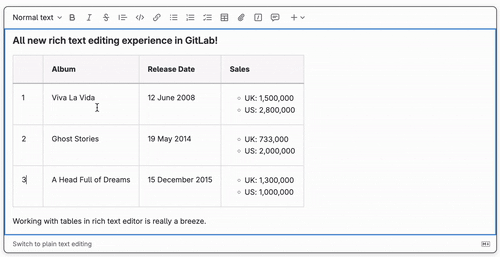16.2
JiHu GitLab 16.2 released with all new rich text editor experience
Today, we are excited to announce the release of JiHu GitLab 16.2 with all new rich text editor experience, command palette, new customization layer for the Value Streams Dashboard and much more!
These are just a few highlights from the 110+ improvements in this release. Read on to check out all of the great updates below.
We thank the wider JiHu GitLab community for the 208 contributions they provided to JiHu GitLab 16.2! At JiHu GitLab, everyone can contribute and we couldn't have done it without you!
GitLab 16.2 features an all-new rich text editing experience! This new capability is available for everyone, as an alternative to the existing Markdown editing experience.
For many, using the plain text editor for comments or descriptions is a barrier to collaboration. Remembering the syntax for image references or working with long tables can be tedious even for those who are relatively experienced with the syntax. The rich text editor aims to break down these barriers by providing a “what you see is what you get” editing experience and an extensible foundation on which we can build custom editing interfaces for things like diagrams, content embeds, media management, and more.
The rich text editor is now available in all issues, epics and merge requests. We plan to make it available in more places across GitLab soon. You can follow our progress here.
We are proud of the new editing experience and can’t wait to see what you think. Please try the new rich text editor and let us know about your experience in this issue.

By default, Flux synchronizes Kubernetes manifests at regular intervals. Triggering a reconciliation immediately when a manifest changes by default requires additional configuration. With the GitLab agent for Kubernetes, you can push a change to your manifest and trigger a Flux sync automatically.
If you’re a power user, using the keyboard to navigate and take action can be frustrating. Now, a new command palette helps you use the keyboard to get more done.
To enable the command palette, open the left sidebar and click Search GitLab (🔍) or use the / key.
Type one of the special characters:
- > - Create a new object or find a menu item
- @ - Search for a user
- : - Search for a project
- / - Search for project files in the default repository branch
When data scientists create machine learning (ML) models, they often experiment with different parameters, configurations, and feature engineering, so they can improve the performance of the model. The data scientists need to keep track of all of this metadata and the associated artifacts, so they can later replicate the experiment. This work is not trivial, and existing solutions require complex setup.
With machine learning model experiments, data scientists can log parameters, metrics, and artifacts directly into GitLab, giving easy access to their most performant models. This feature is an experiment.
We added a new configuration file to the Value Streams Dashboard for easier customization of the dashboard’s data and appearance. In this file you can define various settings and parameters, such as title, description, and number of panels and filters. The file is schema-driven and managed with version control systems like Git. This enables tracking and maintaining a history of configuration changes, reverting to previous versions if necessary, and collaborating effectively with team members.
The new configuration also includes the option to filter the metrics by labels. You can adjust the metrics comparison panel based on your areas of interest, filter out irrelevant information, and focus on the data that is most relevant to your analysis or decision-making process.




